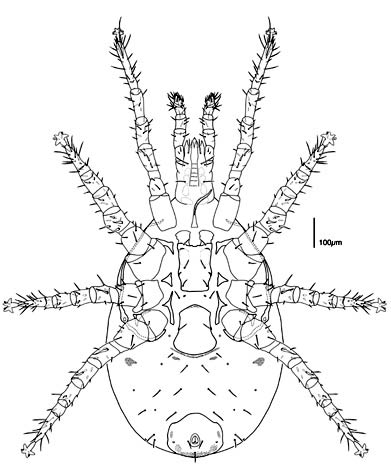| |
Halolaelapidae
Taxonomic
Position
Cohort Gamasina
Subcohort Dermanyssiae
Superfamily Rhodacaroidea
Family: Halolaelapidae
Karg
Halodarcia
Karg, Halolaelaps Berlese & Trouessart (NB – various subgenera
recognized), Halozercon
Wisniewski, Karg & Hirschmann, Leitneria
Evans, Saintdidieria Oudemans, Saprosecans Karg, Saprolaelaps
Leitner
Diagnostic characters:
-
Adult female
usually with 2 subequal dorsal shields, rarely holodorsal or with fragmented
opisthonotal shield
-
Tibia I with 5 dorsal and 3 ventral setae
-
Sternal shield
with 3 pairs of setae, usually free from endopodal elements
-
Palp apotele
3-tined.
Similar taxa.
Halolaelapids are most likely to be confused with Ascidae, but have 3-tined palp
apoteles. Also, ascids with 5 dorsal setae on tibia I usually have holodorsal or
schizodorsal shields: halolaelapids typically have 2 subequal dorsal shields.
Diagnosis. Pale to yellow or brown
dermanyssine mesostigmatans mostly with subequal podonotal and opisthonotal
shields, rarely holodorsal (Halodarcia) or with mesonotal and pygidial
shields (Saprosecans). Peritremes short or long on narrow to broad
shields. Sternal shield rectangular, without endopodal elements (except in
Leitneria) bearing 3 pairs of setae (st1-3) and 2 pairs of lyrifissures
(stp1-2); metasternal shields absent or present and bearing st4, stp3; genital
shield usually trapezoidal to subrectangular and bearing 1 pair of setae;
ventrianal shield broad, bearing 3-4 pairs of ventral setae or reduced to anal
shield with 3 circumanal setae. Tarsus I with claws; trochanter I with 6 setae;
tibia and genu I each with 5/3 dorsal/ ventral setae; genu IV with 9-10 setae,
5/1 dorsal/ ventral; coxae II sometimes with spine (Saprolaelaps).
Chelicerae chelate-dentate; movable digit without excrescences. Palp genu with
6 setae, palp apotele 3-tined; corniculi horn-like. Tritosternum biflagellate
with columnar base. Tectum with long median prong, evenly trifurcate, or
denticulate. Female sperm induction pores at base of coxae IV. Males with
genital opening at base of tritosternum in sternogenital shield; spermatodactyl
usually simple.
Key to common genera of
Halolaelapidae
1. Adult female with
holodorsal or divided dorsal shield; without posterior horn-like processes 2
- Opisthonotal
shield fragmented into mesonotal and pygidial elements; posterior of idiosoma
with horn-like
projections............................................................................................................
Saprosecans
2. Dorsal shield
divided into 2 subequal
shields............................................................. 3
- Dorsal shield
entire...................................................................................
Halodarcia
3. Sternal shield
subrectangular, without endopodal elements; peritreme not expanded
posteriorly 4
- Sternal shield
angular, with fused endopodal elements; peritreme expanded posteriorly
Leitneria
4. Genu III with
9 setae; coxa II without
spine.............................................................. 5
- Genu III with 8
setae; coxa II with anterior spine....................................
Saprolaelaps
5. Genu IV with 9
setae; female with ventrianal shield..................................
Halolaelaps
- Genu IV with 10
setae; female with anal shield........................................
Saintdidieria
References
Blaszak C;
Ehrnsberger R. 1999. A new species of the genus Halolaelaps Berlese &
Trouessart, 1889 (Acari, Gamasida, Halolaelapidae) from the Spanish
Mediterranean coast. Graellsia. 55: 3-7
Evans GO; Fain A.
1995. A new phoretic deuteronymph of Halodarcia Karg (Acari:
Mesostigmata: Halolaelapidae) associated with carabid beetles in Belgium with a
review of the genus. Bulletin de l'Institut Royal des Sciences Naturelles de
Belgique Entomologie 65: 63-71
Gwiazdowicz DJ.
2001. Saprosecans bialoviensis sp. n. (Acari, Halolaelapidae) from
Poland. Biologia (Bratislava) 56(2): 149-153.
Wisniewski,-J;
Karg,-W; Hirschmann,-W. 1992. Gangsystematik der Parasitiformes. Teil
547. Die Adultengattung Halozercon nov. gen., Typenart Halozercon
karacholana nov. spec. aus Sibirien (Halolaelapidae, Ascoidea, Gamasina).
Acarologie (Nuremberg) 39: 180-186.
